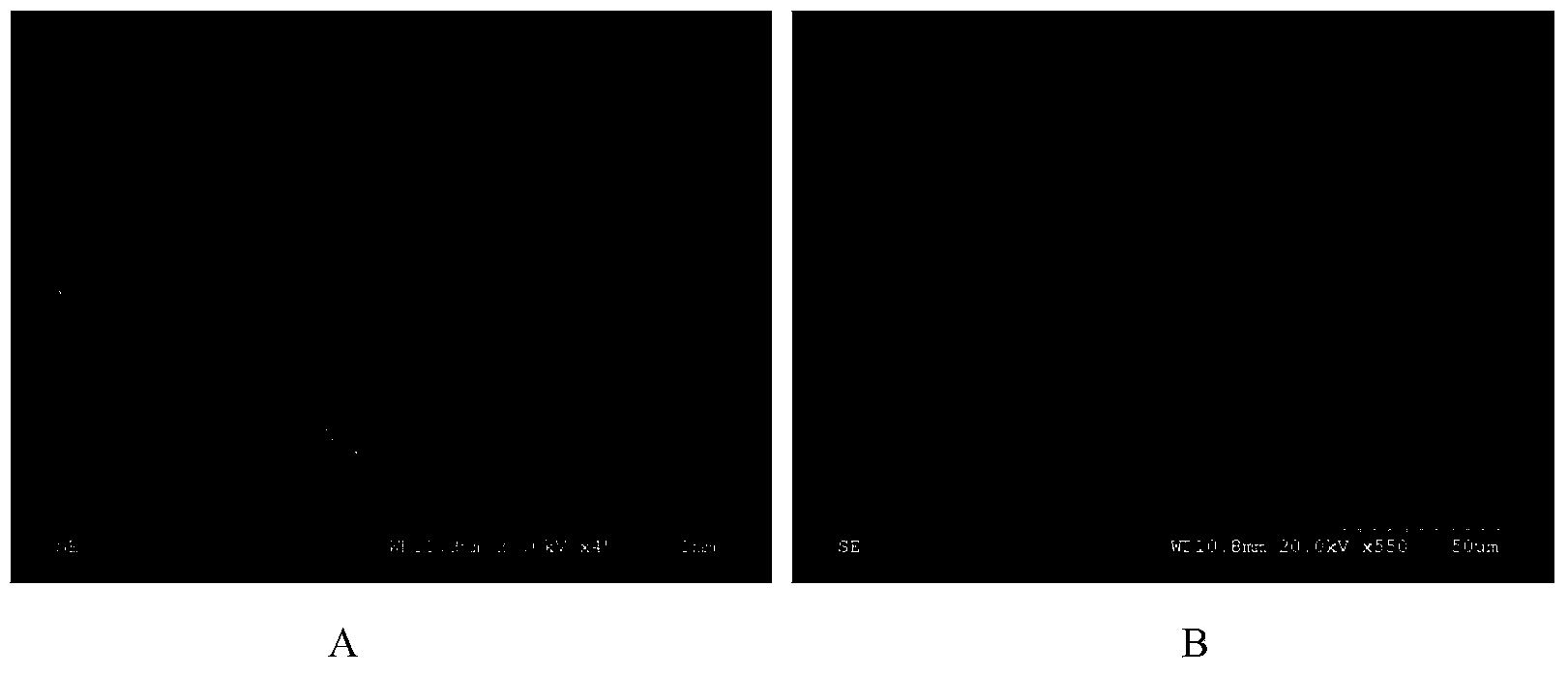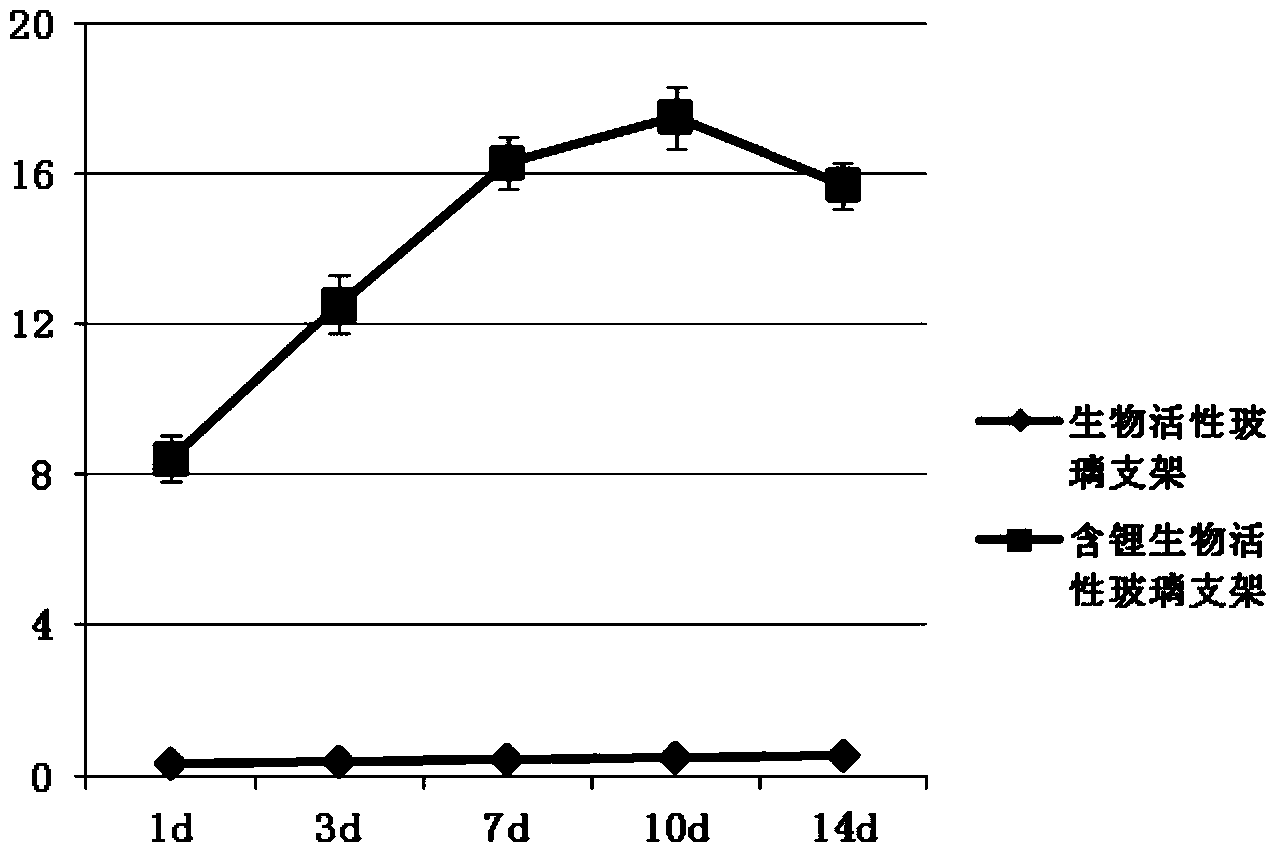Application of lithium-containing natural material bioactive scaffold in osteochondral defect repair
A natural material and bioactive technology, applied in the field of application of lithium-containing natural material bioactive scaffolds in the repair of osteochondral defects, to achieve the effect of promoting bone and cartilage regeneration
- Summary
- Abstract
- Description
- Claims
- Application Information
AI Technical Summary
Problems solved by technology
Method used
Image
Examples
Example Embodiment
[0051] Example 1 Preparation of scaffold:
[0052] (1) Preparation of lithium-containing bioactive glass stent: 5.8g P123, 10g ethyl orthosilicate, 1.5g calcium nitrate tetrahydrate, 0.125g lithium chloride and 1.10g ethyl triphosphate were added to 110ml absolute ethanol, And adjust the pH to 6.5-7.0 with 0.5M hydrochloric acid, and stir at room temperature (37°C) for 24h. Completely immerse the sterile polyurethane sponge (25ppi) in the above solution for 10 minutes, then transfer it to a cell culture dish and place it at room temperature (37°C) for 12 hours, repeat the above process (immersion-place) 3 times, and then sinter at 650°C The organic template was removed for 6 hours to construct a lithium-containing bioactive glass scaffold. See the multiple scanning electron micrograph figure 2 Shown.
[0053] (2) The method of purely bioactive glass scaffold is the same as above, and the purely bioactive glass framework can be obtained by simply removing lithium chloride. See t...
Example Embodiment
[0058] Example 2 Lithium-containing biologically active silk fibroin scaffold
[0059] (1) Preparation of silk fibroin solution: a) Degumming: Put 100g of mulberry silk (Zhejiang Huazhi Silk Co., Ltd., grade 5A) into 5L of 2M sodium carbonate aqueous solution, bath at 96℃ for 30min, and wash with purified water. This process is repeated 3 times to remove the sericin and leave the silk fibroin. The silk fibroin is dried at 50°C to obtain 70g of dried silk fibroin for use; b) dissolution: the above-mentioned dried silk fibroin The protein is dissolved in a 9.3M lithium bromide (LiBr) aqueous solution with a mass-volume ratio of 0.2:1, and the silk fibroin is fully dissolved in a 60°C water bath for 90 minutes to obtain a mixture containing silk fibroin and a small amount of insoluble particles; c) dialysis: The mixed solution was dialyzed with a regenerated cellulose dialysis bag (with a cut-off molecular weight of 4000 Daltons), and then dialyzed with 10 times the volume of the mi...
Example Embodiment
[0066] Example 3
[0067] 1. Animal model establishment and stent implantation
[0068] ① Anesthesia: Calculated at 40mg / kg, intraperitoneally anesthetized with 1% sodium pentobarbital.
[0069] ②Prepare rabbit knee joint skin in a sterile environment: sterilize with 2% iodophor, make an incision about 1 cm in size along the medial edge of the patellar ligament, cut the knee joint layer by layer to expose the knee joint, and use a graduated hand to rotate on the femoral pulley Drill a 4mm diameter and 5mm depth osteochondral defect to complete the model.
[0070] 2. Animal experiment grouping:
[0071] All 18 New Zealand white rabbits were modeled and randomly divided into 3 groups after the defect was made: blank group, simple stent group and lithium-containing stent group, each with 6 rabbits.
[0072] 3. Specimen collection:
[0073] Divide the modeled rabbits in step 1 into three groups, namely a blank group, a simple stent group and a lithium-containing stent group. In the simple st...
PUM
| Property | Measurement | Unit |
|---|---|---|
| Particle size | aaaaa | aaaaa |
Abstract
Description
Claims
Application Information
 Login to View More
Login to View More - R&D
- Intellectual Property
- Life Sciences
- Materials
- Tech Scout
- Unparalleled Data Quality
- Higher Quality Content
- 60% Fewer Hallucinations
Browse by: Latest US Patents, China's latest patents, Technical Efficacy Thesaurus, Application Domain, Technology Topic, Popular Technical Reports.
© 2025 PatSnap. All rights reserved.Legal|Privacy policy|Modern Slavery Act Transparency Statement|Sitemap|About US| Contact US: help@patsnap.com



